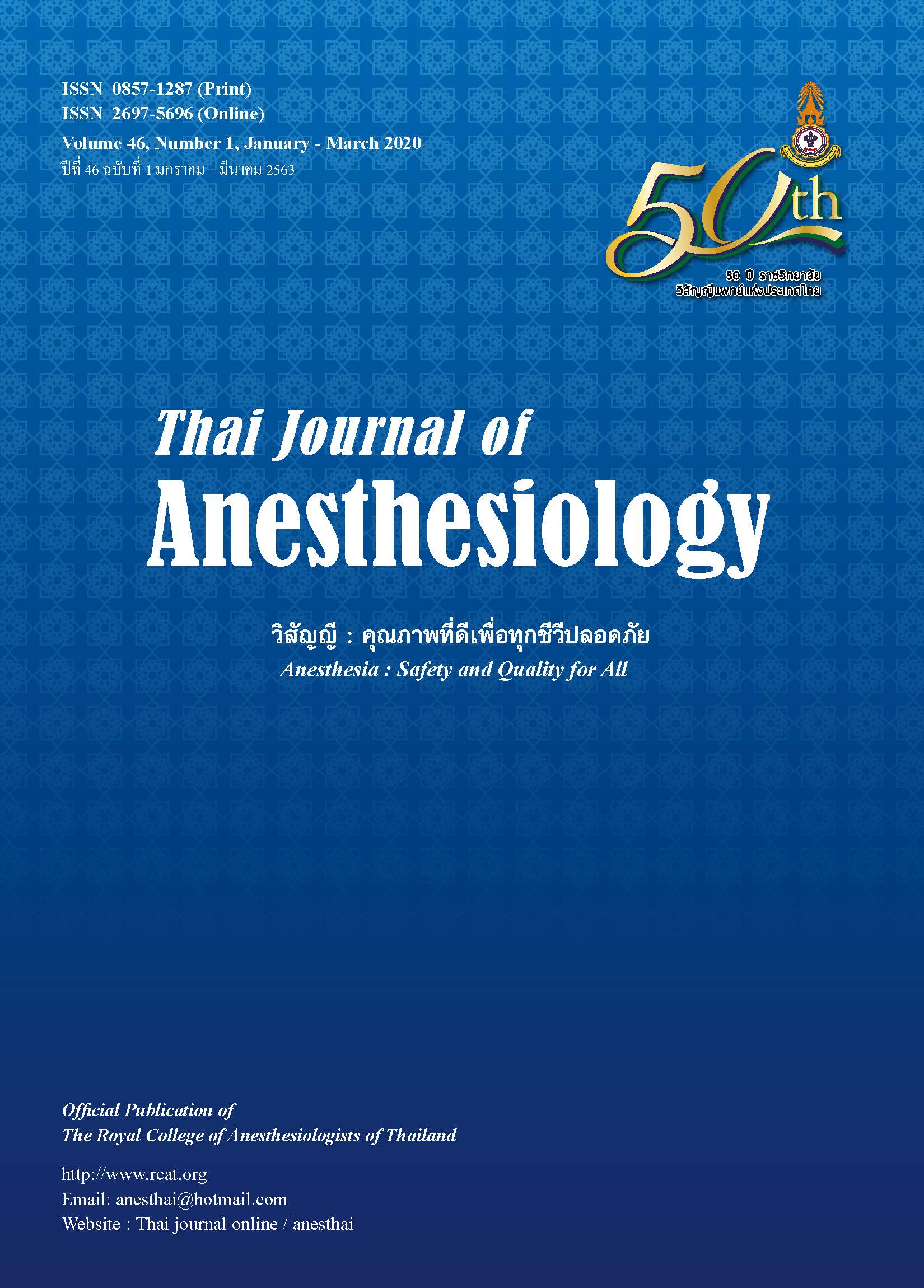Evaluation of the Accuracy and Electrical Properties of the Thai Peripheral Nerve Stimulator for Neuromuscular Blockade Assessment
Main Article Content
Abstract
Background: Many practice guidelines recommend using
a peripheral nerve stimulator during anesthesia with
muscle relaxants to improve patient safety; however it is
not widely available in our country. Thus, a locally
manufactured peripheral nerve stimulator was designed.
This study was aimed to evaluate the electrical characteristics
and accuracy of these peripheral nerve stimulators.
Materials and methods: Peripheral nerve stimulators
(TOF-watch and Thai locally-manufactured) were set to
deliver a train of four stimulation at 50 mA currents into a
resistance loads ranging from 500 to 7000 ohm which
represented the range of patient skin resistance, in same
standard temperature and relative humidity. The current
output, stimulus duration, waveform morphology, and
maximum voltage output were studied using a factorycalibrated
digital oscilloscope.
Results: The stimulation was performed 66 times for each
peripheral nerve stimulator. One sample t-test demonstrate
the current output was higher than set current (50mA) in
both models (P < 0.001, 2.207 [2.050-2.365] vs 3.993
[3.643-4.343] for TOF-watch and Thai peripheral nerve
stimulator respectively). These small differences of the
stimulus current output should not affect clinical
measurement. The morphology of the stimulus performed
by both models was characterized by a regular monophasic
rectangular pulse at all resistance loads. However, both
mean rise time (17.18 vs 6.86 microseconds) and decay
time (13.12 vs 1.44 microseconds) were lower in Thai
peripheral nerve stimulator (P < 0.001).
Conclusions: According to the electrical characteristic
measurement from this study, the Thai peripheral nerve
stimulator was comparable to TOF-watch and further use
in patients should be studied.
Article Details
References
in the PACU after a single intubating dose of nondepolarizing
muscle relaxant with an intermediate duration of action.
Anesthesiology 2003;98:1042-8.
2. Lumb AB, McLure HA: AAGBI recommendations for
standards of monitoring during anaesthesia and recovery
2015-a further example of ‘aggregation of marginal gains’.
Anaesthesia 2016;71:3-6.
3. Lien CA, Kopman AF: Current recommendations for
monitoring depth of neuromuscular blockade. Curropin
Anaesthesiol 2014;27:616-22.
4. Baillard C, Gehan G, Reboul-Marty J, et al. Residual
curarization in the recovery room after vecuronium. Br J
Anaesth 2000;84:394-5.
5. Eriksson LI, Sato M, Severinghaus JW. Effect of a
vecuronium-induced partial neuromuscular block on hypoxic
ventilatory response. Anesthesiology 1993;78: 693-9.
6. Eriksson LI, Sundman E, Olsson R, et al. Functional
assessment of the pharynx at rest and during swallowing in
partially paralysed humans: simultaneous videomanometry
and mechanomyography of awake human volunteers.
Anesthesiology 1997;87:1035-43.
7. Aytac I, Postaci A, Aytac B, et al. Survey of post-operative
residual curarization, acute respiratory events and approach
of anesthesiologists. Braz J Anesthesiol 2016;66:55-62.
8. Murphy GS, Szokol JW, Marymont JH, et al. intraoperative
acceleromyographic monitoring reduces the risk of residual
neuromuscular blockade and adverse respiratory events in the
postanesthesia care unit. Anesthesiology 2008;109:389-98.
9. Drobnik L, Sparr HJ, Thörn SE, et al. A randomized
simultaneous comparison of acceleromyography with a
peripheral nerve stimulator for assessing reversal of
rocuronium-induced neuromuscular blockade with
sugammadex. Eur J Anaesthesiol 2010;27:866-73.
10. Berg H, Roed J, Viby-Mogensen J, et al. Residual neuromuscular
block is a risk factor for postoperative pulmonary complications.
A prospective, randomised, and blinded study of
postoperative pulmonary complications after atracurium,
vecuronium and pancuronium. ActaAnaesthesiolScand
1997;41:1095-103.
11. Jochum D1, Iohom G, Diarra DP, Loughnane F, Dupré LJ,
Bouaziz H. An objective assessment of nerve stimulators
used for peripheral nerve blockade. Anaesthesia 2006;61:
557-64.
12. Naguib M, Brull SJ, Kopman AF, et al. Consensus Statement
on Perioperative Use of Neuromuscular Monitoring.
AnesthAnalg 2018;127:71-80.
13. Checketts MR, Alladi R, Ferguson K, et al. Association of
Anaesthetists of Great Britain and ireland: Recommendations
for standards of monitoring during anaesthesia and recovery
2015: Association of Anaesthetists of Great Britain and
ireland. Anaesthesia 2016;71:85-93.
14. Hadzic A, Vloka JD, Hadzic H, Thys DM, Santos AC. Nerve
stimulators used for peripheral nerve blocks vary in their
electrical characteristics. Anesthesiology 2003;98:969-74.
15. Murphy GS. Neuromuscular monitoring in the perioperative
period. AnesthAnalg 2018;126:464-8.
16. Vincent RD Jr, Brockwell RC, Moreno MC, Adkins SL.
Posttetanic count revisited: are measurements more reliable
using the TOF-Watch accelerographic peripheral nerve
stimulator? J ClinMonitComput 2004;18:33-7.


